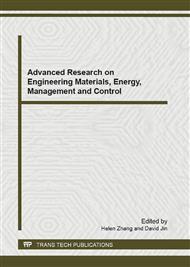p.904
p.908
p.912
p.916
p.923
p.927
p.932
p.936
p.941
The Study on Organic Acid Detection Using Lon Chromatography
Abstract:
A simple and convenient method for the determination of μ g/l level in the real drinking water bromate overcome traditional methods of defects. Argentina by electrolyzing the smallest electrode interference and then focus on extra chlorine use microwave technology foundation evaporation and concentration, the proposed method is very sensitive to the determination of trace level of the sales of the drinking water. And a microwave oven, drinking water ten times the sample can be concentrated in 10 minutes can get and good recovery. Treatment of the silver electrode, the method of interference, and can effectively eliminate the Cl- This method is successfully applied to the detection in water sample level in the trace. It is the advantage of the operation is simple, fast, high sensitivity, accurate results. This method can be applied widely, suitable for trace analysis of water samples.
Info:
Periodical:
Pages:
923-926
Citation:
Online since:
January 2012
Authors:
Keywords:
Price:
Сopyright:
© 2012 Trans Tech Publications Ltd. All Rights Reserved
Share:
Citation:


